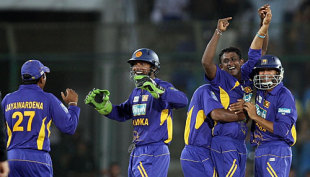For two weeks almost everyone in Karachi - the department store owner, the chemist, the hotel security guard, the hotel manager, the taxi driver - talked cricket. They discussed Pakistan cricket and the lack of stars and, once Pakistan were out of the tournament, they discussed the strengths of the Indian and Sri Lankan teams. But it's probable that none of them, store owner to taxi driver, bothered to actually turn up at the National Stadium. Even an India-Pakistan match could not fill the stands.
It seems, though, the administrators can't see the problem - or, if they can, don't appear too concerned. Nasim Ashraf, the PCB chairman, called a press-conference in the middle of the
Pakistan-Bangladesh game, one of the many one-sided games, and suggested the crowds didn't know what they were missing.
The likely truth is, the crowds knew what they were missing. Because these matches were played in the heat of June and July, and with a fair sprinkling of mismatches - five out of six in the first round - there was hardly anything drawing the paying public to the grounds. One of the reasons why Ashraf thought this Asia Cup was the greatest thing since sliced bread was because more than 600 were being scored in every match. It is time administrators stopped disrespecting the audience's intelligence: a flat wicket, predictably yielding 600 runs, with batsmen getting out due more to fatigue than the skills of their opponents, and bowlers present to make up the numbers, is not cricket, even for fans in the subcontinent. The new rule that has the ball changed after 34 overs hasn't helped matters either; reverse-swing, the only potent weapon left with the bowlers, was conspicuously absent.
Two of the matches - when
Pakistan played India to stay alive in the tournament, and the
final - did portray what the 50-over game still has going for it. Pakistan fought back having been taken for 88 runs in the first ten overs, India rebuilt after losing four quick wickets, but Pakistan again bowled smartly in the death overs to provide another twist in the game. The final oscillated even more; Ishant Sharma wrecked the Sri Lanka top order, Jayasuriya returned the favour with a blinding counterattack, Virender Sehwag threatened to run away with the match, but Ajantha Mendis came up with one of the sensational spells of our times.
These two matches were good because there was time: for teams to come back, for teams to sustain the lead if they have managed to take it, for the batsmen to pace and build an innings, and for the bowlers to set batsmen up. But to have only two such matches out of 13 is not ideal.
Pakistan, the hosts, fielded one of their most unexciting teams since the 1970s; the flair in their bowling was missed the most. Their leadership lacked direction, their captain and coach fought embarrassingly with the media, and they were one of the reasons the Asia Cup take didn't take off at all. They confounded when they beat India, in true Pakistani fashion, but in a measure too little and at a time too late.
As it turned out the Asia Cup didn't do much, with Twenty20 gradually forcing 50-over cricket into existential crisis, to give the fillip this form of the game needed. The only bright spots of the tournament were the revealing of Ajantha Mendis, the return of Sanath Jayasuriya, 16 years his senior, and Bangladesh's first innings against India in which Alok Kapali scored a stroke-filled century. And all along a creepy feeling accompanied the mind: would not the stands be filled had this been a Twenty20 over Asia Cup?

